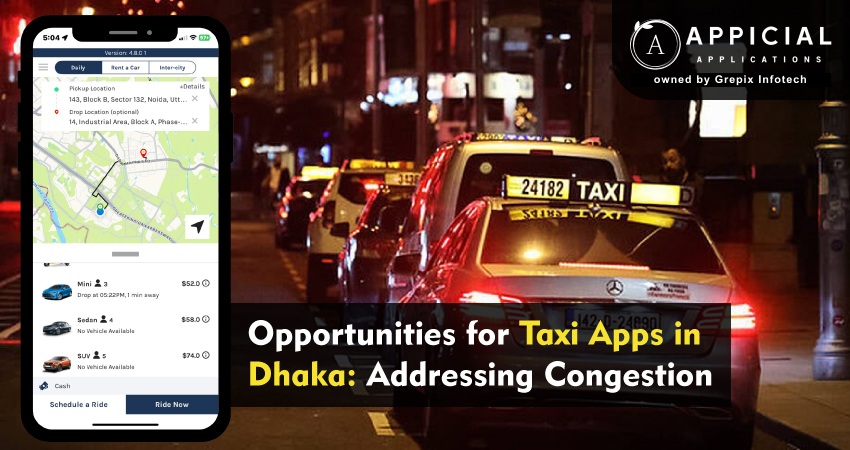
Opportunities for Taxi Apps in Dhaka: Addressing Congestion
Let’s talk about it, Dhaka’s traffic. If you're from here, you know exactly what I mean. The continuous honking, the endless wait, and the plodding through what appear to be traffic bottlenecks that have existed since the break of day. On some days, the city's traffic seems to have a life of its own, and it's not a nice one.
The point I keep making, though, is that there are always untapped possibilities behind major issues. Furthermore, I can't help but think that taxi apps may be one of the tools we're ignoring when I observe how people move around this city. So let's dissect it.
Dhaka’s traffic is a daily struggle we all know too well. But inside that problem lies an opportunity. Dhaka taxi app services and ride-hailing Bangladesh platforms could help reduce congestion if we use them right, from encouraging shared rides to linking up with public transport. This blog took a deep look at how these apps could go beyond offering convenience and actually help tackle the bigger problem. From promoting shared rides that get more people into fewer cars, to designing apps that integrate smoothly with buses, trains, and other public transport, these tools could fit into the puzzle of real traffic solutions Dhaka urgently needs. But realizing that vision won't happen on its own. App developers, the government, designers of cities, and, to be honest, all of us who drive every day must work together intelligently. Choosing the right tech partner is crucial because of this matter.
Dhaka’s traffic: A daily struggle that affects us all
Dhaka’s a city that’s grown faster than its roads ever could. The numbers are mind-boggling, over 20 million people packed into this urban sprawl, all trying to get where they need to go. And the roads? They were never meant for this.
I don’t need to tell you about sitting in a jam on Mirpur Road or stuck near Gulistan. You’ve been there. We’ve all been there. Sometimes, it feels like the city’s moving backwards , literally. Studies say that the average speed of vehicles in Dhaka during peak hours is about 7 km/h. That’s slower than a bicycle. Some days, it’s slower than walking.
And this isn’t just a minor annoyance. It’s costing the economy billions in lost productivity, wasted fuel, and health problems from all that pollution. It’s cutting into people’s time with their families. It’s fraying nerves.
So where do we even start fixing this? Well, building more roads isn’t always the answer, the space just isn’t there. But making better use of what we’ve got? That’s where taxi apps come in.
Why taxi apps could be part of the solution
Let’s be real, when most of us hear about a Dhaka taxi app, we think of the basics: getting a ride without the headache. No more arguing over fare, no more standing in the rain trying to flag down a CNG, no more wondering if the driver will go where you want.
But here’s what often gets overlooked: these apps can do so much more than just save you from a bad commute. They actually hold real potential to help ease the traffic chaos we deal with every day. And no, I’m not saying they’re a magic fix, but they can be a piece of the bigger puzzle if we use them smartly.
Let me break down how:
- Fewer private cars on the road.: Look, we all know someone who’s bought a car (or is thinking about it) just because they’re fed up with unreliable transport. However, people no longer believe that owning a car is their only choice when ride-hailing services in Bangladesh are dependable, secure, and reasonably priced. This implies a minor but significant reduction in traffic, fewer cars clogging the roads, and fewer cars vying for parking spaces.
- Smarter routing.: In addition to connecting drivers and passengers, a good Dhaka taxi app aids in route planning. Additionally, these apps can direct drivers away from construction zones, accidents, and bottlenecks using real-time data. Traffic becomes somewhat more dispersed rather than crammed onto the same major roads.
- Sharing rides.: Here’s a big one. What if sharing a ride wasn’t seen as something you do only when you have to? Imagine if it became the normal, easy choice, because the app made it simple, safe, and maybe even cheaper. Fewer cars are required to transport the same number of people when one car can accommodate two or three passengers rather than just one. It's easy math, but what about the effect on traffic?
- Blending with public transport.: This is something I get excited about. The smartest taxi apps don’t just think about point A to point B, they think about how to help you with the whole journey. Maybe that means a quick ride to the bus stop, or getting you to the station for the metro when it’s ready. Instead of competing with public transport, these apps could work hand-in-hand with it. That way, we’re not just adding cars to the road, we’re making it easier to leave the car at home altogether.
I’m not saying taxi apps will solve everything, but they could take a serious bite out of the problem if we use them smartly.
Also Read: Taxi App Development in Manila: Meeting Urban Demand
How do we get there? A realistic roadmap
It’s one thing to talk about potential. But what would it actually take to make taxi apps part of the answer to Dhaka’s traffic mess? I’ve been thinking about that, and here’s what I see.
- Taxi apps need to work with the government, not around it: A Dhaka taxi app can’t do much good if it’s clashing with city policies or dodging regulations. The apps need to be part of official transport plans, not just a business on the side. That means licensing, safety standards, driver training, the whole package.
- Make shared rides the easy choice: Many people still use taxi apps alone at the moment. Using an app to choose a shared ride can be more cost-effective or profitable. Perhaps the government also provides some assistance, such as fuel discounts for drivers who participate in more group travel.
- Open up the data: Numerous pieces of information about where, when, and how people move are gathered by taxi apps. That information (in anonymous form) could be used by city planners to help with everything from traffic light timing to deciding where to put a new bus stop.
- Help drivers succeed: Drivers are the backbone of any ride-hailing Bangladesh service. They need fair pay, support for things like fuel or maintenance, and tools to help them drive smarter, not just harder. If drivers are happy, they’ll stick with the apps and offer better service.
- Link up with other transport modes: Picture this: you use one app to plan a trip that combines a shared taxi, a bus, and (when it’s ready) the metro. No gaps. No guesswork. That’s the kind of seamless travel we need.
This isn’t a one-player game; who needs to step up?
If taxi apps are going to help fix Dhaka’s traffic, everyone’s got to pull together.
- The government sets the rules of the game.: They can make policies that encourage shared rides, smooth app-based public transport integration, and ensure safety isn’t compromised.
- Taxi app companies: The tech is there. The challenge is using it to help the city, not just the bottom line.
- Us, the people: Everybody has options. Planning our trips, using public transportation when it's available, and opting to share rides are all important decisions.
- Employers: Little things like providing flexible work schedules and promoting carpooling can make a big difference.
- Researchers, NGOs, and urban planners: They can help keep the focus on solutions that help everyone, not just the lucky few who can afford to avoid the worst traffic jams.
Will taxi apps change the scenario?
So, will taxi apps magically make the traffic vanish? No. But could they be a serious part of the fix? I really believe they could. Especially if we think bigger than just the next ride. If we use these apps to move more people with fewer vehicles, to connect trips, to make smart use of data, that’s where the magic happens.
And that’s why I want to give a shout-out to Appicial Applications. We don’t just build taxi apps, we build solutions. Custom taxi apps that can be tailored to Dhaka’s unique challenges. Apps that can integrate with public transport, support shared rides, and help cities move smarter.
If you’re part of a startup, a transport company, or even a city agency looking for ways to make a dent in Dhaka’s traffic problem, give them a look. Because this city deserves better. And with the right tools, I believe we can get there.
Looking out to start your own venture like Uber ? Try out our HireMe Taxi Uber Clone, the easiest way to kick-start your taxi business.Author's Bio

Vinay Jain is the Founder at Grepix Infotech and brings over 12 years of entrepreneurial experience. His focus revolves around software & business development and customer satisfaction.
Back to blog list




